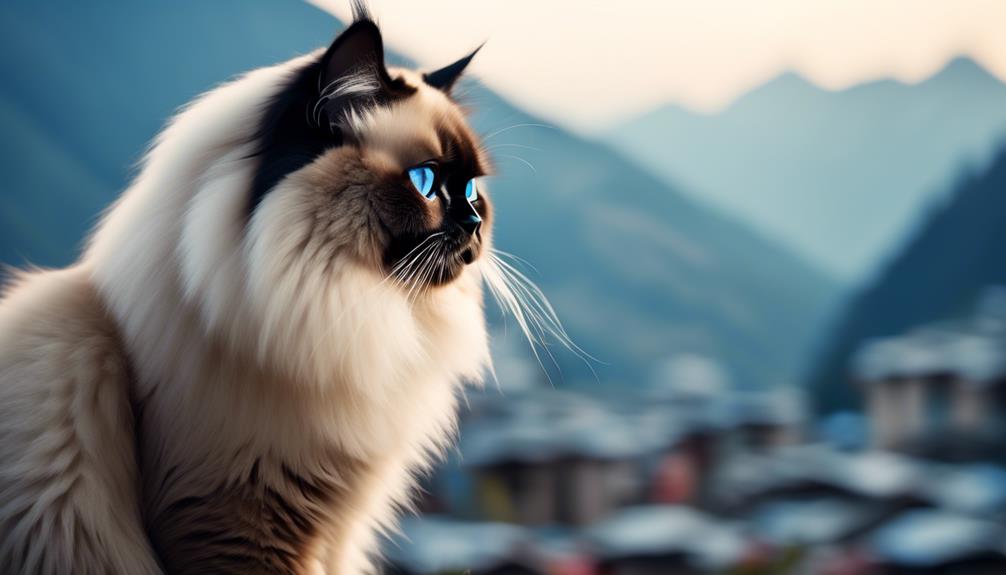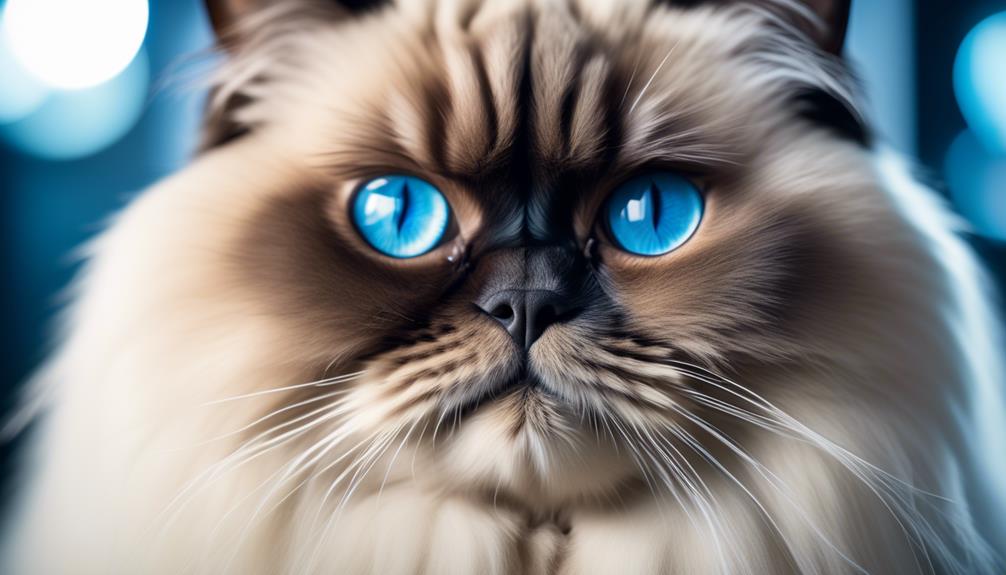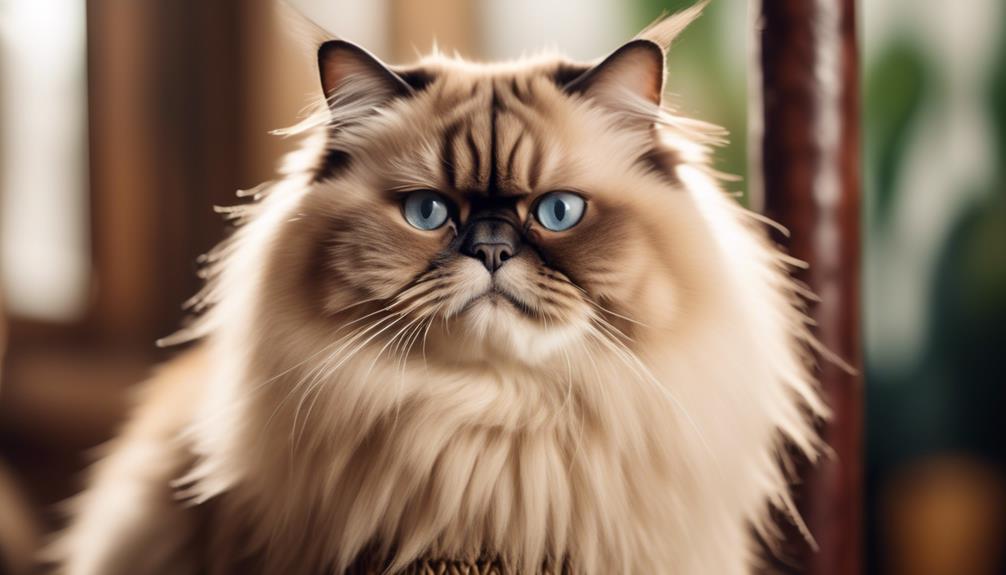
With their striking color points and luxurious coats, Himalayan cats have a mysterious allure that captivates feline enthusiasts worldwide.
These regal creatures, descendants of the Persian breed, offer a unique blend of elegance and charm.
But there is more to the Himalayas than meets the eye.
From their gentle nature to their specific grooming needs, there are many fascinating aspects to explore.
So, what makes these cats truly special? And how do they differ from their Persian relatives?
Let’s dive into the captivating world of Himalayan cat breed information and characteristics to uncover the secrets behind their timeless beauty and charming personalities.
Key Takeaways
- Himalayan cats are gentle, calm, and affectionate, making them great companions.
- They have a long, silky coat that requires regular grooming to prevent matting.
- Himalayans are prone to respiratory and dental issues, as well as kidney disease and heart conditions.
- These cats prefer a quiet and serene environment and can get along well with children and friendly dogs if introduced properly.
Origin and Size
The Himalayan cat breed originated in the United States in the early 20th century.
They are known for their medium to large size and are a part of the Persian breed group.
These cats have a lifespan of 12 to 15 years.
They have a long, silky coat with color points, which adds to their unique appearance.
Regarding temperament and personality, Himalayans are gentle, calm, and affectionate.
They are quiet cats who enjoy lounging and the company of their owners.
While they are not particularly active, they may require patience in training.
Grooming is essential for the Himalayas, as their long coat requires regular brushing to prevent matting.
They may also be prone to respiratory and dental issues, as well as kidney disease and heart conditions.
See another cat breed profile.
Japanese Bobtail Cat Breed
Temperament and Personality

Himalayan cats, known for their gentle and calm nature, have a distinct temperament and personality.
These cats are described as quiet and enjoy lounging, making them perfect companions for those who prefer a peaceful environment.
They are social creatures and enjoy the company of their owners, often seeking out affection and attention.
While the Himalayas are not particularly active cats, they still require mental stimulation and playtime.
Training may require patience, as they can be a bit stubborn at times.
Key personality traits of the Himalayan breed include affectionate, docile, quiet, loyal, and intelligent.
Overall, Himalayans make wonderful pets for individuals or families seeking a loving, low-key companion.
| Temperament and Personality |
|---|
| Gentle |
| Calm |
| Affectionate |
| Quiet |
Grooming and Health

Regular grooming is essential for maintaining the health and appearance of Himalayan cats.
Here are some important points to keep in mind when it comes to grooming and the health of these beautiful felines:
- Daily brushing prevents matting and keeps their long, silky coat looking their best.
- Regular eye cleaning may be necessary to address tear stains and keep their eyes clear and healthy.
- Himalayans are prone to respiratory and dental issues, so regular veterinary check-ups and dental care are crucial.
- They’re also at risk for kidney disease and heart conditions, making regular monitoring and genetic testing important.
- Both pedigreed and mixed-breed Himalayans can have potential health problems, so staying informed and proactive is key to their well-being.
Appearance and Coat

With their large round head, round eyes, and small ears with rounded tips, Himalayan cats have a distinct and adorable appearance.
These cats are known for their long, thick, shiny, and fine-textured coats that require regular grooming to prevent matting.
They have an immense ruff around their neck and a full tail, adding to their regal appearance.
Himalayans come in various paint colors, including chocolate, seal, lilac, blue, red, and cream tortie.
Their deep, vivid blue eyes are captivating and contribute to their charm.
The breed has two different looks: extreme and traditional, with the outer Himalayas having a flatter face.
Their appearance and gentle and affectionate nature make them a beloved choice for cat lovers.
| Appearance | Coat |
|---|---|
| Large round head | Long, thick, shiny, and fine-textured |
| Round eyes | Immense ruff around the neck |
| Small ears with rounded tips | Full tail |
| Deep, vivid blue eyes | Variety of paint colors |
Care and Compatibility

To ensure the well-being of Himalayan cats, it’s important to provide them with proper care and create a compatible environment.
Here are some key points to consider:
- Daily grooming: Himalayan cats have long coats that require daily brushing to prevent matting and keep them clean and tangle-free.
- Litter box cleanliness: Regular litter box cleaning is crucial to prevent litter from getting stuck in their paws or coats.
- Eye cleaning: Due to their facial structure, Himalayans may have excessive tearing, so daily cleaning of the eyes is necessary.
- Dental hygiene: Regular brushing is important to prevent periodontal disease, a common issue in this breed.
- Quiet environment: Himalayans prefer a serene and calm atmosphere, so providing them with a peaceful living space is important.
Training and Behavior

Now, let’s shift our focus to the training and behavior of Himalayan cats.
Himalayans have a gentle and calm nature, making them easy to handle and train.
While they are not particularly active cats, they enjoy the company of their owners and are known to be loyal and affectionate.
However, training a Himalayan may require some patience, as they can sometimes be a bit stubborn.
It is important to establish boundaries and provide positive reinforcement during training sessions.
Here is a table summarizing the training and behavior characteristics of Himalayan cats:
| Training and Behavior |
|---|
| Gentle and calm nature |
| Enjoy the company of their owners |
| Not particularly active |
| It may require patience in training |
| Affectionate and loyal |
| Intelligent |
Himalayans are intelligent cats and can learn various tricks and commands with consistent training.
It is recommended to start training them from a young age to establish good behavior habits.
Himalayan cats can be well-behaved and obedient companions with the right approach and positive reinforcement.
Common Health Issues

Himalayan cats are prone to a variety of common health issues. These include:
- Respiratory issues: Due to their short nose and flat face, Himalayans may experience difficulty breathing and are prone to upper respiratory infections.
- Dental problems: Their facial structure can also lead to dental issues such as overcrowding, tooth decay, and gum disease.
- Kidney disease: Himalayas have a higher risk of developing kidney disease, which can lead to kidney failure if not properly managed.
- Heart conditions: They’re susceptible to heart conditions such as hypertrophic cardiomyopathy, which affects the heart muscle.
- Eye problems: Himalayans are prone to eye conditions like cherry eye, entropion, and tear duct obstructions.
It is important for Himalayan cat owners to be aware of these health issues and to provide regular veterinary care to ensure their cat’s well-being.
Frequently Asked Questions
Are Himalayan Cats Hypoallergenic?
No, Himalayan cats are not hypoallergenic. They have long, silky coats that can trap allergens like dander.
People with allergies may still experience allergic reactions to Himalayan cats despite their gentle and affectionate nature.
How Do Himalayan Cats Handle Being Left Alone for Long Periods?
Himalayan cats may struggle with being left alone for long periods.
They are social cats who enjoy the company of their owners.
Giving them attention and stimulation is important to prevent loneliness and boredom.
Are Himalayan Cats Prone to Obesity?
Himalayan cats can be prone to obesity if not properly managed. Regular exercise, portion control, and a balanced diet are essential to maintain a healthy weight.
Owners should monitor their cat’s food intake and provide opportunities for physical activity.
Do Himalayan Cats Have a Tendency to Be Vocal?
Himalayan cats do tend to be vocal. They may meow to communicate their needs or seek attention.
However, they are generally quiet and not excessively vocal compared to other cat breeds.
Can Himalayan Cats Be Trained to Walk on a Leash?
Yes, Himalayan cats can be trained to walk on a leash.
They are intelligent and can learn to adjust to a harness and leash with patience and positive reinforcement training methods.
Conclusion
In conclusion, the Himalayan cat breed is a serene and affectionate companion known for its gentle nature and beautiful long coat.
While they may require regular grooming and patience in training, their calm temperament, and social nature make them a wonderful addition to any home.
It’s important to be aware of the potential health concerns associated with this breed. Still, with proper care and attention, the Himalayans can live a happy and fulfilling life for 12 to 15 years.




